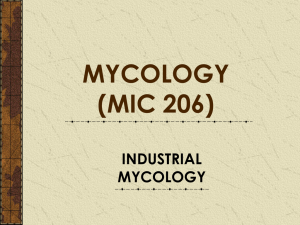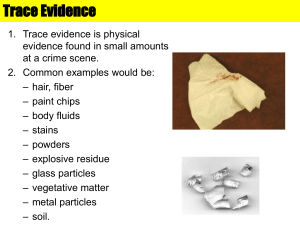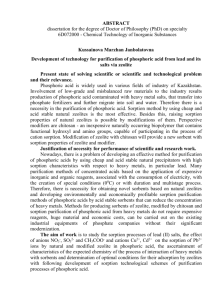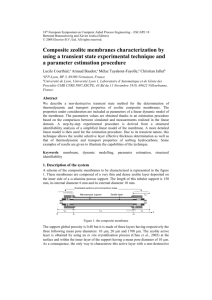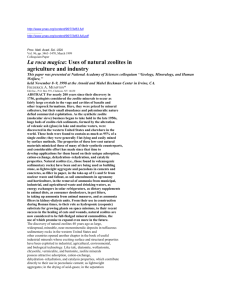Presentation Tutu H. et al Biosorption based on P. Simplicissimum
advertisement
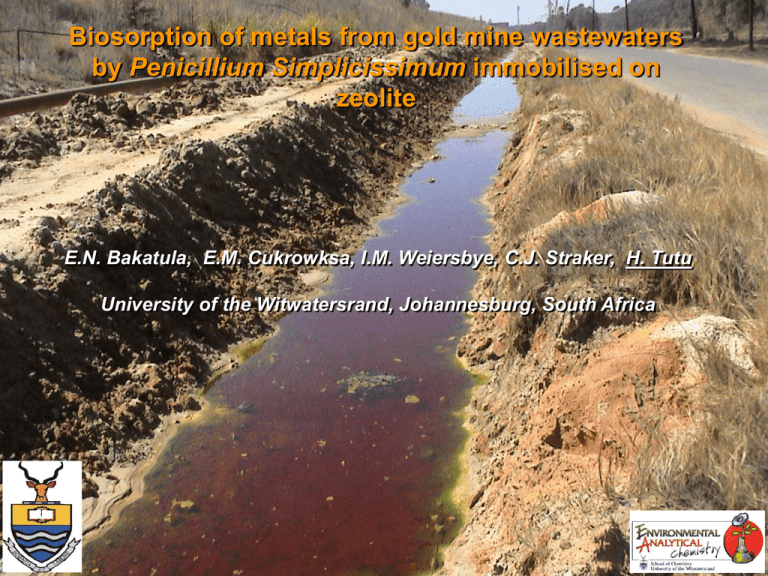
Biosorption of metals from gold mine wastewaters by Penicillium Simplicissimum immobilised on zeolite E.N. Bakatula, E.M. Cukrowksa, I.M. Weiersbye, C.J. Straker, H. Tutu University of the Witwatersrand, Johannesburg, South Africa Over 70 minerals have been identified in the primary ores: quartz, pyrite, pyrrhotite, galena, arsenopyrite, gersdofite, sphalerite, urananite… More than 50 000 tons of gold mined leaving behind more than 244 mine tailings dumps. More than 35 000 tons of gold still remain in deep resources 4 - 6 billion tons of mine waste ~30 million tons of sulphur (Witkowski and Weiersbye, 1998) ~430 000 tons of low-grade uranium (Winde et al., 2004) Rising tide of acid mine water threatens Johannesburg “The water is currently around 600 m below the city’s surface but is rising at a rate of between 0.4 and 0.9 m per day” - Telegraph, 6 Sep 2010 Gold extraction • Cyanidation of gold-bearing ores (Elsner’s equation): 4Au + 8CN- + O2 + 2H2O => 4Au(CN)-2 + 4OHAcid mine drainage 2FeS2 + 7O2 + 2H2O => 2FeSO4 + 2H2SO4 4FeSO4 + O2 + 4H2O => 2Fe2O3 + 4H2SO4 Neutralisation CaCO3 + H2SO4 => CaSO4 + H2O + CO2 Water from slimes dam collected in water retain reservoirs (Courtesy: Prof. T.S. McCarthy) Broken down pumps result in leakage of contaminated water to natural water bodies Elevated elements include S, Mg, U, Fe, Cu, Mn, Zn, Pb, Ni, As, Cr, U (Coetzee et al., 2003; Naicker et al., 2005; Tutu et al., 2008). Evaporation Seepage and surface flow “Reactive transport modelling” To underlying aquifer Leached solution + Solid minerals → Predicted solution + “New” contact solution “New” predicted solution Barriers for containment of toxic elements Precipitation barrier e.g. liming to precipitate elements, pH dependent Evaporation barrier e.g. evaporation of salt-laden shallow groundwater Redox barrier e.g. precipitating elements using redox differentials Adsorption barrier e.g. can be natural or engineered e.g. reactive barriers Biosorptive properties of fungi: Penicillium simp. Biosorption - property of biomaterials as bacteria, yeast, fungi, agriculture wastes, etc. to bind and to concentrate metals from aqueous solutions by active (metabolically) and passive modes (physico-chemical pathways) Metal sorption and accumulation depends on diverse factors, such as pH, temperature, organic matter, ionic speciation and the presence of other ions in solution which may be in competition, etc. Many potential binding sites are present in fungal cell walls, including chitin, amino, carboxyl, phosphate, sulfhydryl and other functional groups, which may act individually or synergistically to bind cations. Structure of zeolite Zeolite structure is mainly composed of 3 components: alumino-silicate framework (with a repeating pore network), exchange cations and water within the pores. The general formula is: (M2+, M2+)O. Al2O3. gSiO2. zH2O M+ = Na + or K + ; M2+ = Mg2 +, Ca2 + or Fe2 + They have a net negative charge due to isomorphous replacement of Si4+ by Al3+ and this negative charge is balanced by the extra-framework cations (Na+, K+, Ca2+ and Mg2+). Both Si/Al ratio and the cation contents determine the properties of most zeolites. Two main mechanisms are attributed to heavy metal removal by natural zeolites: (i) ion exchange and (ii) adsorption Ion exchange properties of zeolites are due to the weakly bonded extra-framework cations which are mobile and easily exchanged with solution cations. It is a good adsorbent and ion-exchange agent which is determined by its unique structure and large specific surface area. Thus, it has found wide applications in wastewater treatment research. The zeolite was selected due to its capacity for immobilising micro-organisms and to its large surface area. EXPERIMENTAL WORK Penicillium simpliccissimum was maintained on the following solid media: 40 g L-1 Potato Dextrose Agar (PDA) and 50 g L-1 Malt Extract Agar (MEA). For experimental purpose, cultures were grown at 25oC in liquid medium at pH 2 to 7, comprising the following: (NH4)2SO4, KCl, MgSO4.7H2O, EDTA-Fe, ZnSO4.7H2O, MnSO4.H2O, CaCl2.2H2O, K2HPO4, yeast, glucose in 1 L of sterilised deionised water. 1 g of zeolite was added to the medium, the mixture was inoculated after autoclaving. The immobilized biomass was separated from the broth by filtration and washed with deionised water. Penicillium simp. strains Growth of penic.simp. after 5 days Light Microscopy (100X) Penicillium strains are halotolerants (able to grow in presence or absence of salt). Batch and column sorption experiments were done in living as well as inactive biomass for Co, Cu, Fe, Hg, Cr, Ni, U and Zn metals (single and multicomponent solutions). The concentrations of metals remaining in solution were determined using ICP-OES. RESULTS AND DISCUSSION Zeolite – Composition and characteristics XRF characterisation of zeolite Constituent Value (%) Surface area: 69 m2/g Si O2 40.6 Al2O3 32.92 Average pore volume : 0.002 cm3/g Fe2O3 0.01 Average pore diameter: 150 Å FeO 0.08 CEC: 61.06 meq/100 g MnO 0.01 MgO 0.06 CaO 0.03 Na2O 19.92 K2O 0.25 TiO2 0.02 P2O5 0.01 H2O 6.1 Growth curves for Penicillium simp. 100 600 500 pH 2 60 pH 3 pH 4 pH 5 40 pH 6 Harvest (mg) Harvest (mg) 80 pH3 300 200 100 0 0 5 10 15 Day Penicillium simp. 20 25 pH4 pH5 20 0 pH2 400 pH6 0 5 10 15 20 25 Day Zeolite-Penicillium simp. The growth of fungus showed ~ 10-fold increase in biomass when immobilized on zeolite (600 mg/g at pH 4). Elemental analysis of the biomass CEC C H N S meq/100 g % % % % ZeoliteFungi 82.50 0.388 2.295 0.254 0.102 Natural zeolite 61.06 0.219 2.209 n.d n.d The % of C was high in the biomass; these results confirm the presence of organic compounds released by the fungi as revealed by with the IR spectra. Characterization of the biomass SEM analysis revealed that the biofilm covered uniformly the zeolite surface. Infrared spectra of the biomass pointed to more compounds released after 10 days of inoculation and confirmed the presence of functional groups which include: hydroxyl, carbonyl, carboxyl, amine, imidazole, phosphate groups. Adsorption studies Kinetic models and sorption isotherms Mathematical models (Pseudo 1st and 2nd order and Intraparticle diffusion models) were employed for the prediction and comparison of the binding capacity and to design the sorption process. The ‘isotherm’, a curve describing the retention of a substance on a solid at various concentrations, is a major tool to describe and predict the mobility of this substance in the environment. Langmuir and Freundlich isotherms are the most commonly used. Models have an important role in technology transfer from a laboratory scale to industrial scale. Adsorption studies….. Effect of contact time (Zeolite-Living fungi) Kinetics 25 25 Cu Cu 20 Cr U 15 Fe Ni 10 Cr Qe (mg/g) Qe (mg/g) 20 Equilibrium U 15 Fe Ni 10 Hg Hg Co 5 Co 5 Zn Zn 0 0 0 50 100 150 200 Time (min) Single component syst: Ci = 100 mg/L pH 3 (2.5 g in 500 mL) 0 50 100 150 200 Time (min) Multi component syst: Ci = 100 mg/L pH 3 (2.5 g in 500 mL) The biosorption was fast (10 minutes) and the kinetics includes 2 phases: (1) associated with the external cell surface and (2) intra-cellular accumulation/ reaction depending on the cellular metabolism. Effect of contact time (Zeolite-Inactive fungi) Kinetics 60 60 50 Cu 50 Cu Cr U Fe 30 Ni Hg 20 Cr 40 Qe (mg/g) Qe (mg/g) 40 U Fe 30 Ni Hg 20 Co 10 Zn 0 Co Zn 10 0 0 50 100 150 200 Time (min) Single component syst: Ci = 100 mg/L pH 3 (2.5 g in 500 mL) 0 50 100 150 200 Time (min) Multi components syst: Ci = 100 mg/L pH 3 (2.5 g in 500 mL) Inactive microbial biomass frequently exhibits a higher affinity for metal ions than viable cells, probably due to the absence of competing protons produced during metabolism. Kinetics of metal ion sorption governs the rate, which determines the residence time and it is one of the important characteristics defining the efficiency of an adsorbent. Kinetic models (Zeolite – Inactive fungi) Metal ions Cu2+ Co2+ Cr3+ Fe2+ Hg2+ Ni2+ UO22+ Zn2+ Pseudo first-order parameters Pseudo second-order parameters Intraparticle diffusion parameters qe K1 /[min-1] R2 qe K2/[g mg-1 min-1] R2 Kid/[mg g min] C R2 0.022 0.075 0.715 0.168 0.062 0.999 0.005 0.028 0.829 0.014 0.072 0.618 0.182 0.0574 0.998 0.006 0.031 0.928 0.034 0.065 0.794 0.206 0.0505 1.000 0.007 0.034 0.842 0.012 0.011 0.466 0.193 0.054 1.000 0.006 0.032 0.936 0.072 0.029 0.751 0.0305 0.526 0.992 0.002 0.004 0.865 0.002 0.02 0.507 0.183 0.057 1.000 0.006 0.031 0.928 0.033 0.019 0.846 0.0174 0.425 0.773 0.007 0.002 0.982 0.005 0.014 0.625 0.164 0.063 0.999 0.005 0.028 0.927 The pseudo 2nd order model (dqt / dt = k2 (qe – qt)2 fits better the biosorption kinetics. The film and pore diffusion equations (Df = 0.23 r0 δ qe / t½ and Dp = 0.03 r02 / t½ ) were used to check whether the diffusion step controlled ion exchange or not . Df = the film diffusion coefficient (cm2/s), Dp = the pore diffusion coefficient (cm2/s), r0 = the radius of zeolite , δ = the film thickness (0,001 cm, assuming the geometry of the spherical particles) and t½ is the half time for the ionexchange process (min). The film diffusion coefficient was in the range of 2.03 x 10-6 and 3 x 10-7 cm2/s for the metals studied. The pore diffusion coefficient was between 3.55 x 10-7 and 0.52 x 10-7 cm2/s. The metal diffusion through the film is the rate limiting step. According to Michelson: Df = 10-6 - 10-8 cm2/s and Dp = 10-11 10-13 cm2/s. Effect of pH (Zeolite-Living fungi) Isotherms Langmuir and Freundlich isotherms were used to fit the experimental data. 30 30 25 Cu Cu 25 Cr Qe(mg/g) 20 U Fe 15 Ni 10 Hg Co 5 Zn 0 2 3 4 5 pH 6 7 8 Single component syst: Ci = 500 mg/L (1 g in 100 mL) Qe (mg/g) Cr U 20 Fe 15 Ni Hg 10 Co 5 Zn 0 2 3 4 5 6 7 8 pH Multi-component syst: Ci = 500 mg/L (1 g in 100 mL) An increase of AC was observed for U at pH 5 which is close to its hydrolysis pH. N [ i2+ ]TO T = 8 5 .1 9 mM 1 L og C onc . -1 N i2+ H N iO ( H )2 (c ) + -3 NO i H -5 + N i2O H -7 -9 2 OH 3 4 pH 5 6 Nickel species distribution using Medusa software 3+ Effect of pH (Zeolite-Inactive fungi) Isotherms 60 60 Cu 50 Cr U 40 Fe 30 Ni 20 Hg 10 Co Qe (mg/g) Qe (mg/g) 50 Cu Cr U 40 Fe 30 Ni 20 Hg Co 10 Zn Zn 0 0 2 3 4 5 6 7 8 pH Single component syst: Ci = 500 mg/L (1 g in 100 mL) 2 3 4 5 6 7 8 pH Multi-component syst: Ci = 500 mg/L (1 g in 100 mL) The presence of Fe2+ and Zn2+ was found to influence uranium uptake in the multi-component system. AC was constant ( 40-50 mg/g) at the pH range 2 - 7 for Cu2+, Fe2+, Hg2+, Co2+ , Zn2+ . Qe (mg/g) Effect of pH (Natural zeolite) 12 Cu 10 Cr 8 U 6 Fe Ni 4 Hg 2 Co 0 2 3 4 5 6 7 8 Zn pH Natural zeolite, single component syst. Ci = 500 mg/L (1 g in 100 mL) Competition between cations and protons for binding sites means that sorption of metals like Cu, Cr, Ni, Co and Zn is often reduced at low pH values. Effect of Temperature (Zeolite-Living fungi) Thermodynamics (Ea, ΔGo and ΔHocalculated from the experimental data. ) 25 Qe (mg/g) Cr U 15 Fe 10 Ni Qe (mg/g) Cu 20 25 Cu 20 Cr U 15 Hg 5 Co Co 0 Zn Zn 20 0 20 30 40 50 60 17.49 -80.57 -6.424 109.9 -75.84 -27.91 -120.4 -113.2 ∆ Ho kJ/mol 104.4 -481.0 -38.32 651.1 -452.4 -166.6 -718.9 -675.7 40 50 60 70 Temperature (oC) Multicomponent syst: Ci = 100 mg/L, pH = 3 (0.5 g in 100 mL) Single component syst: Ci = 100 mg/L, pH = 3 Ea kJ/mol 30 70 Temperature (o C) Cu Cr U Fe Ni Hg Co Zn Ni 10 Hg 5 Fe ∆ Go kJ/mol 25oC -17.66 -6.232 -1.513 -25.96 0.986 -5.860 -5.689 -7.373 40oC -18.09 -12.78 -1.833 -22.24 -5.200 -6.896 -12.75 -19.47 60oC -19.29 -16.58 -2.484 -16.89 -7.767 -9.978 -20.64 -21.72 Physisorption: 5 ≤ Ea ≤ 40 kJ mol-1 Chemisorption: 40 ≤ Ea ≤ 800 kJ mol-1. ΔG = -RTln Kd Kd = qe/Ce Thermodynamics (Ea, ΔG and ΔH Effect of Temperature (Zeolite - Inactive fungi) calculated from the experimental data) 30 30 Cr U 20 Fe 15 Ni Hg 10 Qe (mg/g) Qe (mg/g) Cu Cu 25 25 Cr 20 U Fe 15 Ni 10 Hg Co 5 Zn Co 5 Zn 0 0 20 30 40 50 60 70 20 Single component syst: Ci = 100 mg/L pH=3 (0.5 g in 100 mL) Cu Cr U Fe Ni Hg Co Zn -1.338 19.80 12.16 10.35 -64.18 -42.62 82.64 3.637 ∆H kJ/mol -7.986 21.71 -254.4 493.2 118.2 -383.0 61.80 72.56 40 50 60 Temperature (oC) Temperature (o C) Ea kJ/mol 30 25oC -14.04 -25.75 1.483 -21.28 -16.86 0.460 -19.51 -19.02 Multi-component syst: Ci = 100 mg/L pH = 3 (0.5 g in 100 mL) ∆G kJ/mol 40oC -20.37 -27.29 -1.964 -22.31 -16.30 -3.593 -19.81 -20.22 60oC -23.08 -29.04 -2.735 -24.65 -16.97 -7.007 -21.11 -21.34 70 Effect of initial concentration (Multi-component system) Ni U Hg 30 25 2.48165 2.48805 2.49045 9.9944 24.98135 10 25 9.9925 24.9926 Hg Co Zn 60 Cu 50 Cu Cr U Fe 15 Ni Hg 10 U 40 Qe (mg/g) 20 Qe (mg/g) Cr Fe 30 Ni Hg 20 Co Zn Co 10 Zn 5 0 0 0 0 100 200 300 400 500 600 200 400 600 Concentration (mg/L) Concentration (mg/L) Zeolite-Living fungi, pH= 3 (1 g in 50 mL) Zeolite-Inactive fungi, pH= 3 (1 g in 50 mL) The metal uptake was constant for all the metals studied except for Ni, Hg and U. For these metals, the uptake decreases until an initial concentration of 200 mg/ L for Ni and Hg; 400 mg/ L for U, most probably because of the xenobiotic effect. Desorption % Desorption studies 120 Cu 100 Cr 80 U Fe 60 Hg 40 Ni 20 Zn 0 Co 0 2 4 6 8 [HNO 3] M Zeolite- Inactive fungi, Ci = 100 mg/L The metal loaded in the biomass can potentially be desorbed in order to regenerate the biosorbent and to reclaim valuable metals. This biosorbent was used 5 times without any loss of its adsorption properties. Application on mine effluent Sampling site SW1 3.8 383.6 pH SO42(mg/L) SW2 7.2 19.8 Ci Cf % Fe 6.10 0.018 99.7 Ni 6.00 0.012 99.8 Zn 4.30 0.004 99.9 Ci Pit water 3.2 1669 Cf % Ci Cf % Ci Cf % 4.50 0.004 99.9 5.80 0.006 99.9 0.60 < DL 99.8 1.80 0.010 99.4 4.70 0.005 99.9 10.70 0.010 99.9 1.60 0.002 99.9 1.70 0.005 99.7 14.80 0.015 99.9 0.30 0.005 98.3 0.04 < DL 97.5 Hg 0.30 < DL 99 U 0.20 < DL 100 Cr 0.040 % SW4 5.6 653.6 Ci 1.60 Cf SW3 4.1 819.4 97.5 Ci = initial metal concentration (mg L-1 ) ; Cf = final conc. % = Removal % (1 g in 50 mL) Discharge standards for industrial wastewater (SAWQG) pH 6–9 Fe 0.3 mg L-1 Ni 0.05 mg L-1 Zn 5 mg L-1 Cr 0.01 mg L-1 Hg 0.002 mg L-1 After treatment with the zeolite-fungi, the quality of the effluent complied with the discharge standards for industrial wastewater. Conclusions The biosorbent displayed good adsorption of toxic metals even at low pH values, making it an ideal sorbent for metals in effluents. Biosorption was described to be easy, safe, rapid, inexpensive and can be used to recover heavy metals at very low concentration. Non viable microbial biomass frequently exhibits a higher affinity for metal ions than viable cells, probably due to the absence of competing protons produced during metabolism. Accumulation of metals from solutions by fungi can be divided into three categories: (1) biosorption of metal ions on the surface of fungi. (2) intracellular uptake of metal ions. (3) chemical transformation of metal ions by fungi In the environment, Penicillium simpl. can grow in the silica matrix (tailings dams) at low pH and adsorption of toxic metals occurs at that pH. Outlook Application to the recovery of metal complexes (e.g. cyanide complexes) and metalloids (e.g. As) Exploring cheaper sources of silica e.g. fly ash, zeolites, liquid glass Acknowledgements • The Carnegie Corporation • The National Research Foundation • The Friedel Sellschop Foundation • AngloGold Ashanti
